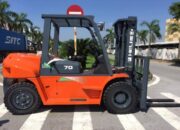Driving instruction video of Kalmar DRF450 container, this is a container forklift with a load of up to 45 tons, allowing 5 floors of containers, with 3 rows of containers.
học lái xe nâng container ở đâu | Xe nâng container Kalmar
xe nâng container, xe nâng container kalmar






